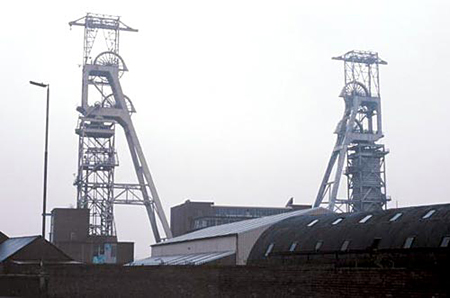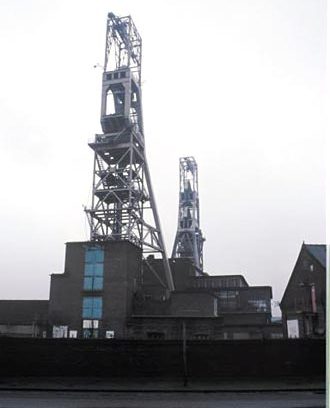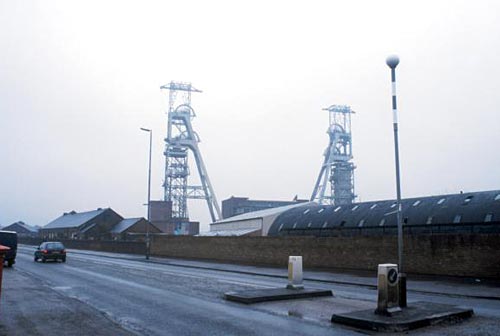This website uses cookies
This website uses cookies to enable it to function properly and to analyse how the website is used. Please click 'Close' to accept and continue using the website.





May 2006 - Clipstone Colliery, Mansfield, Nottinghamshire
Text and Images by Stephen Miles
Two miles east of Mansfield in Nottinghamshire lies a twentieth-century village. A mining-village. Established by the Bolsover Colliery Company by the early 1920s, New Clipstone, located just west of the original village of Old Clipstone, served the then new Clipstone Colliery. This was part of a general expansion eastwards into the Dukeries and the deeper coalfield.
By the Second World War, the seam being worked was becoming exhausted. Deeper seams had to be developed, so a programme of reconstruction and reorganisation was drawn up just after the war. The National Coal Board (NCB) took on the scheme upon nationalisation in 1947-48.
The plan was for both underground and surface reorganisation. On the surface, works had started in earnest by 1953. The old steam winders, boilers, and fan, were scrapped; the winding houses, headframes, boiler house, fan house and heapstead buildings demolished. They were replaced by new heapsteads, headframes, a fan house, and a winder/power house located between the two shafts, with two electrically powered winders. The consultant architects for this scheme were Young and Purves of Manchester.
New buildings contained new machinery, and in the case of the winding system, a different form from that of established practice. By the late 1940s, it was common for collieries in the UK to use drum winding to raise and lower miners and materials in the shafts. However, the period after the war saw the coal industry investigating relatively new technology, some of which was already established in other countries. One system already adopted in Europe was that of ‘Koepe’ or Friction winding. This uses a single loop of rope, or two or more ropes in parallel, and a powered pulley or ‘Koepe’ wheel to move things along, rather than the standard drum. The system is under balance, needing less power for operation, and was invented in Germany in 1877 by Frederick Koepe. Interestingly the first British example was installed at Bestwood Colliery, Nottinghamshire, in the 1880s. This did not prove successful, and was soon taken out.
The system was installed at a few more collieries up to the 1930s, but did not enjoy widespread use. It took the reconstruction programme of the NCB in the 1950s and 1960s to encourage further adoption. Clipstone was one of the first post war examples of this system, but surprisingly, here the NCB went for ground based winders, rather than the by now more usual system of winders installed in towers over the shafts. This of course, required the use of headframes, and the ones at Clipstone use pulley wheels or ‘sheaves’ located one above the other, designed specifically for Koepe winding, rather than the more normal way of sheaves next to each other. The winder house contained the two electrically driven Koepe winders, and two motor generator sets to convert the public AC supply to DC. This configuration pretty much remained as this until closure in 2003.
The heapsteads are two monolithic brick buildings, enclosing the areas beneath the headframes. The central winder house is a modernist brick and glass affair. A few of the original 1920s ancillary buildings remain on the site. But it is the sculptural qualities of the two magnificent headframes, which were the tallest in the UK when built, standing at approximately 65m high, which are the real landmarks. They can be seen for a few miles around, but the best view has to be looking eastwards along the straight of Mansfield Road, running through New Clipstone, and at the end of the vista, the two headframes rising up forming almost a gateway appearance.
The 1950s rebuilding of the headgear and winder house were listed in 2000 as an “early example of the ‘Koepe’ system” according to the list description. Whilst not the first built, it seems that it is the earliest in situ example left in the UK. The architecture of the rebuilding is good for a mid twentieth century colliery, it seems the site is an unusual survival of an early NCB reconstruction. The only other post war colliery structures to have statutory protection in England are located at Chatterley Whitfield colliery, these forming part of the scheduled complex. They include a winder house, a fan house, and a grade II listed store.
This technical interest has not stopped demolition proposals. In 2003, a referendum in Clipstone was held, with the villagers voting overwhelmingly for demolition of the complete site. The Coal Authority has made a listed building consent application for demolition, but the site still stands, albeit with the 1930s baths house (mentioned by Pevsner) now demolished. It may not be long before a real monument to the post war coal industry is lost.
Further reading:
Stephen Miles is a member of the Twentieth Century Society, with a particular interest in industrial archaeology
Look for past Buildings of the Month by entering the name of an individual building or architect or browsing the drop down list.

Become a C20 member today and help save our modern design heritage.